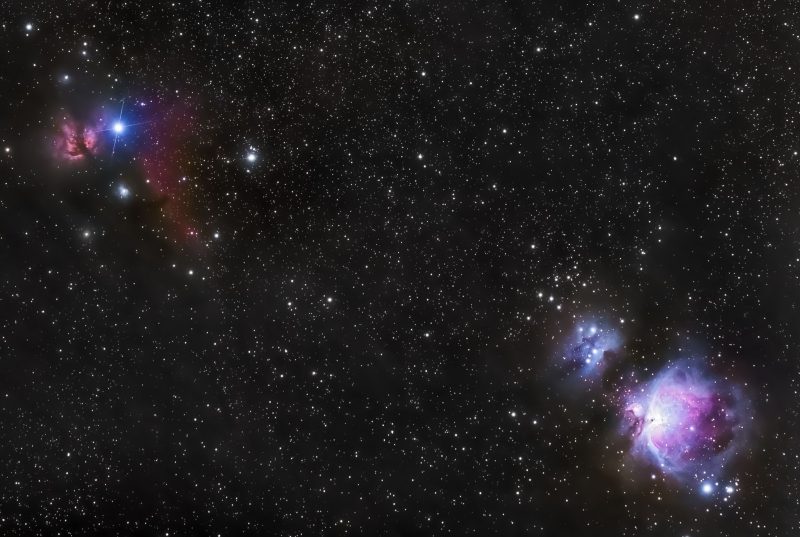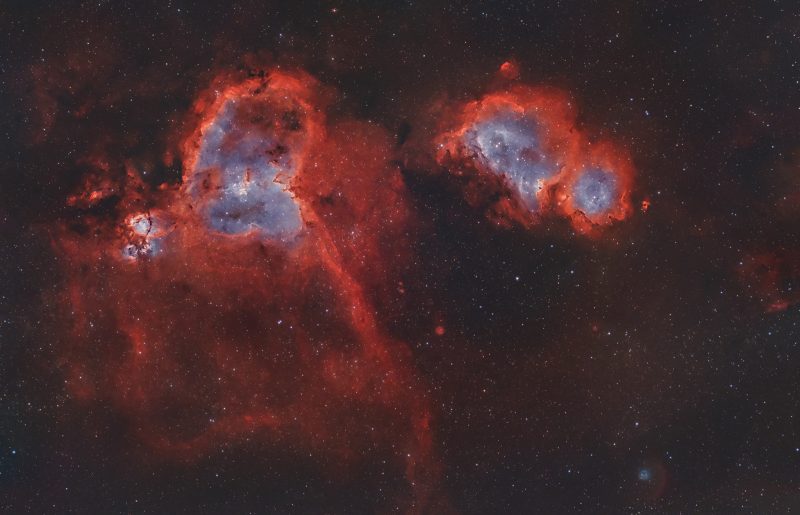
October deep sky photos
Explore the depths of October’s deep sky with these amazing photos taken by photographers and friends of EarthSky. You, too, can spot the Helix Nebula in Aquarius, the Orion and Flame nebulas in Orion, and the Heart and Soul Nebulas in Cassiopeia from dark-sky locations.
The Helix Nebula
NGC 7293, the catalog name for the Helix Nebula, is located in the constellation of Aquarius. The Helix Nebula shines at magnitude 7.3. This is bright enough to spot in small telescopes or even binoculars. Just keep in mind that the glowing gas from this nebula is rather spread out, about half the size of a full moon, making it a challenge to observe.
The Helix Nebula is one of the largest and closest planetary nebulas to us. A planetary nebula consists of gas and dust expelled from a star at the end of its life. The Helix Nebula provides a glimpse into our own sun’s future, after it reaches the red giant phase and begins to release its gases. The star seen at the center of the Helix Nebula is the one responsible for the gaseous outflow. If this were the sun, our planet would be well within the nebula. The sun and the star in the Helix Nebula will eventually end their lives as white dwarfs.
The Hubble Space Telescope took a famous photo of the Helix Nebula in 2003. Email chains at the time referred to this nebula as the Eye of God. You may recognize this photo as one of the décor items inside the apartment on the TV show The Big Bang Theory. It hung in the alcove of Sheldon and Leonard’s apartment for many years.
Orion and Flame nebulas

Look for these nebulas in the constellation Orion in October. Orion is rising in the east late in the evening. The Orion Nebula is part of the sword of Orion. It can be seen as a fuzzy patch without any optical aid. The Flame Nebula lies next to the bottom-most belt star of Orion, Alnitak. Can you also spot the Horsehead Nebula in this photo?
Heart and Soul nebulas

These beautiful nebulas lie in the constellation Cassiopeia. Cassiopeia is an easy-to-spot constellation in the shape of the letter W. The Heart Nebula is sometimes called the Running Dog Nebula. What does this star-forming region look like to you?
Bottom line: EarthSky readers shared amazing deep-sky photographs with us. The Helix Nebula in Aquarius, Orion and Flame nebulas in Orion, and Heart and Soul nebulas in Cassiopeia are great observing targets for October.
The post October deep sky: Helix Nebula and more first appeared on EarthSky.
from EarthSky https://ift.tt/30Fjov9

October deep sky photos
Explore the depths of October’s deep sky with these amazing photos taken by photographers and friends of EarthSky. You, too, can spot the Helix Nebula in Aquarius, the Orion and Flame nebulas in Orion, and the Heart and Soul Nebulas in Cassiopeia from dark-sky locations.
The Helix Nebula
NGC 7293, the catalog name for the Helix Nebula, is located in the constellation of Aquarius. The Helix Nebula shines at magnitude 7.3. This is bright enough to spot in small telescopes or even binoculars. Just keep in mind that the glowing gas from this nebula is rather spread out, about half the size of a full moon, making it a challenge to observe.
The Helix Nebula is one of the largest and closest planetary nebulas to us. A planetary nebula consists of gas and dust expelled from a star at the end of its life. The Helix Nebula provides a glimpse into our own sun’s future, after it reaches the red giant phase and begins to release its gases. The star seen at the center of the Helix Nebula is the one responsible for the gaseous outflow. If this were the sun, our planet would be well within the nebula. The sun and the star in the Helix Nebula will eventually end their lives as white dwarfs.
The Hubble Space Telescope took a famous photo of the Helix Nebula in 2003. Email chains at the time referred to this nebula as the Eye of God. You may recognize this photo as one of the décor items inside the apartment on the TV show The Big Bang Theory. It hung in the alcove of Sheldon and Leonard’s apartment for many years.
Orion and Flame nebulas

Look for these nebulas in the constellation Orion in October. Orion is rising in the east late in the evening. The Orion Nebula is part of the sword of Orion. It can be seen as a fuzzy patch without any optical aid. The Flame Nebula lies next to the bottom-most belt star of Orion, Alnitak. Can you also spot the Horsehead Nebula in this photo?
Heart and Soul nebulas

These beautiful nebulas lie in the constellation Cassiopeia. Cassiopeia is an easy-to-spot constellation in the shape of the letter W. The Heart Nebula is sometimes called the Running Dog Nebula. What does this star-forming region look like to you?
Bottom line: EarthSky readers shared amazing deep-sky photographs with us. The Helix Nebula in Aquarius, Orion and Flame nebulas in Orion, and Heart and Soul nebulas in Cassiopeia are great observing targets for October.
The post October deep sky: Helix Nebula and more first appeared on EarthSky.
from EarthSky https://ift.tt/30Fjov9

Aucun commentaire:
Enregistrer un commentaire